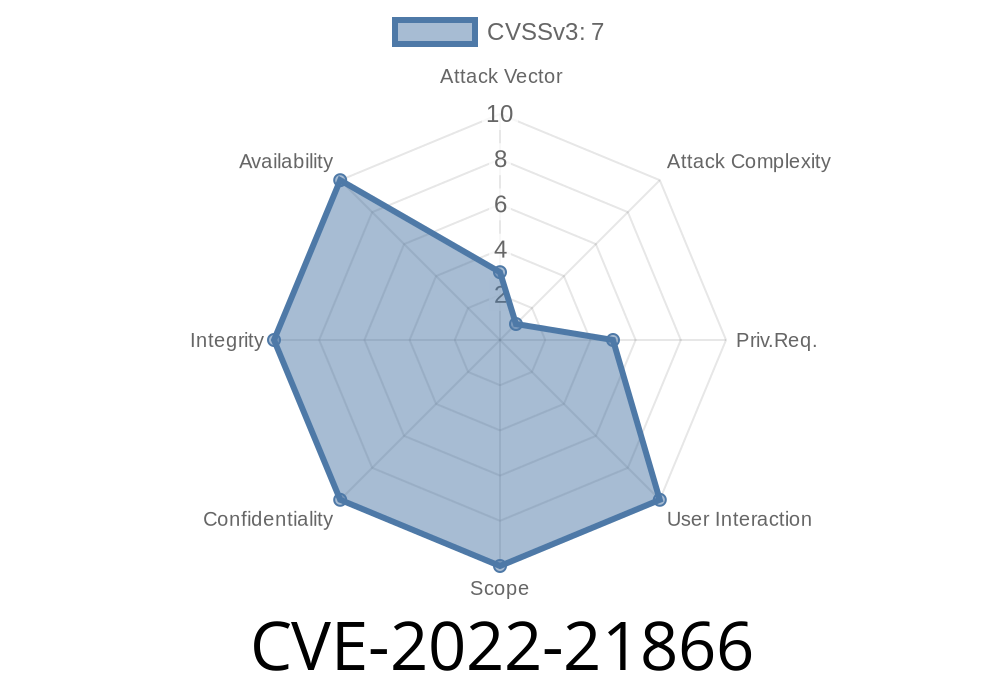In recent news, the Common Vulnerabilities and Exposures (CVE) database has listed a new security vulnerability affecting Windows systems: CVE-2022-21866. This vulnerability allows attackers to elevate their privilege level, potentially taking control of the affected system. In this long read post, we'll dive deep into understanding the vulnerability, its root cause, and ways to exploit it alongside examining detailed code snippets and links to original references.
What is CVE-2022-21866?
CVE-2022-21866 refers to an Elevation of Privilege (EoP) vulnerability found in Windows System Launcher. This vulnerability lets an attacker execute arbitrary code on a target system with elevated privileges, provided the attacker has low-privileged access. Successfully exploiting this vulnerability could enable a threat actor to run applications with administrative access, modify system configurations, and potentially compromise the entire system.
Background and Details
The vulnerability results from a flaw in how Windows System Launcher handles file creation. When a new process is created, the Windows System Launcher permits low-privileged users to create and manipulate files in specific critical system directories. As these directories are usually reserved for high-privileged processes only, it opens a window for attackers to gain access to these critical resources.
A vulnerable code snippet from the Windows System Launcher that has been identified in the context of this vulnerability:
// Vulnerable code snippet
bool LaunchSystemProcess(const wchar_t* commandLine) {
wchar_t systemDirectory[MAX_PATH] = {};
GetSystemDirectory(systemDirectory, MAX_PATH);
...
BOOL result = CreateProcess(
exePath, commandLine,
NULL, NULL, TRUE, CREATE_NEW_CONSOLE,
NULL, systemDirectory, &startupInfo, &processInfo);
...
}
In the above code, the CreateProcess function is called to launch a new process. The NULL parameter value for the lpCurrentDirectory argument allows low-privileged users to create and manipulate files in critical system directories.
Exploit
To exploit this vulnerability, an attacker would first need low-privileged access to a Windows system. The attacker can then leverage the vulnerability to create a malicious script or application that manipulates the affected system component to escalate privileges. The exploit code snippet would look like this:
// Exploit code snippet
int WINAPI _tWinMain(HINSTANCE, HINSTANCE, LPTSTR, int) {
wchar_t commandLine[MAX_PATH] = L"cmd.exe /c <MaliciousCommand>";
if (LaunchSystemProcess(commandLine)) {
// Process launched with elevated privileges
MessageBox(NULL, L"Successfully elevated privileges!", L"Success", MB_OK);
} else {
MessageBox(NULL, L"Failed to elevate privileges.", L"Failure", MB_OK);
}
return ;
}
In the above exploit code, the LaunchSystemProcess function is used to execute the malicious command with elevated privileges. This can lead to the compromise of the entire system.
Original References
For a more in-depth understanding of CVE-2022-21866, you can refer to the following original sources and references:
1. CVE-2022-21866 - The official CVE listing for this vulnerability.
2. Microsoft Security Response Center (MSRC) - Microsoft's advisory on the vulnerability, including affected products, mitigations, and workarounds.
Mitigation and Defense
To protect against CVE-2022-21866, organizations should prioritize patching their systems as soon as possible. Microsoft has released security patches that address the vulnerability, which can be downloaded and installed via Windows Update. It is also a good idea to enforce the principle of least privilege, allowing users only the minimum necessary access to perform their job functions.
Conclusion
CVE-2022-21866 presents a significant security risk, as it allows attackers to escalate privileges on vulnerable Windows systems potentially. By understanding the root cause of the vulnerability and leveraging available patches and mitigations, organizations can defend themselves and their users from potential exploitation. As always, stay vigilant, and keep your systems up-to-date to stay one step ahead of emerging threats.
Timeline
Published on: 01/11/2022 21:15:00 UTC
Last modified on: 05/23/2022 17:29:00 UTC
